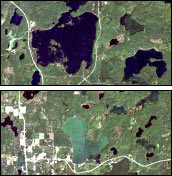

 |
|||
|
|||
Unless you are a toad or a swamp rat, chances are you don’t want to live on the
edge of a smelly, algae-filled lake. Most people like their lakes clean, clear, and fresh. This is
particularly true for those who reside in the Upper Midwest. Lakes there are central to people’s lives.
Not only do they provide an outlet for recreation and an ideal setting to connect with nature, but they
also draw in the bulk of the tourist trade. No one wants to see the pristine lake they fish on or swim
in become polluted. Unfortunately, monitoring water quality for the 30,000 plus lakes in the Upper Great
Lakes region has never been possible. Water quality measurements have always been taken by hand, and the
states have traditionally had the resources to monitor only a small percentage of their lakes. Such
modest samplings cannot give researchers a comprehensive view of water quality throughout the
states. |
|||
|
Minnesota is known as the land of 10,000 lakes—a claim which is actually an understatement. Most of these lakes are relatively clean, like Lake Everett, providing the perfect environment for a secluded canoe trip or fishing expedition. Urbanization and agricultural runoff are, however, degrading water quality, particularly in the south of the state. Researchers at the University of Minnesota are developing new techniques to monitor water clarity and lake health, which will help identify trends in water quality. (Photograph copyright Kevin Judd) | ||
Recently, scientists at the University of Minnesota working on a NASA project
arrived at a solution. Using imagery from Landsat satellites, the scientists have mapped the water
clarity for over 10,000 of Minnesota’s lakes at a relatively low cost. The maps have allowed them to
evaluate water quality patterns across the state as well as provide the tools for monitoring lakes to
the state. In the future, the scientists in Minnesota will combine their map with similar maps being
created at the University of Wisconsin and Michigan State University to create a comprehensive water
quality map for the entire Upper Great Lakes region. The data used in this study are available in one or more of NASA's Earth Science Data Centers. |

Satellites can image a much wider area than can be effectively monitored from the ground. This pair of true-color Landsat images compares a clear, clean lake (top) with a lake with poor water quality (lower). (Images courtesy Upper Great Lakes Regional Earth Science Applications Center) |